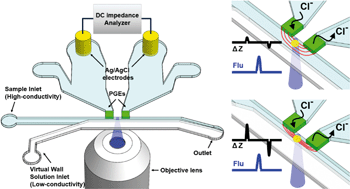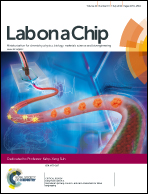A flow cytometry-based submicron-sized bacterial detection system using a movable virtual wall†
Abstract
Detection of pathogenic bacteria requires a sensitive, accurate, rapid, and portable device. Given that lethal microbes are of various sizes, bacterial sensors based on DC (direct current) impedance on chips should be equipped with channels with commensurate cross sections. When it comes to counting and interrogation of individual bacteria on a microfluidic chip, very narrow channels are required, which are neither easy nor cost-effective to fabricate. Here, we report a flow cytometry-based submicron-sized bacterial detection system using a movable virtual wall made of a non-conducting fluid. We show that the effective dimension of a microfluidic channel can be adjusted by varying the respective flow rates of a sample solution as well as the liquid wall therein. Using such a virtual wall, we have successfully controlled the channel width and detected submicron-sized Francisella tularensis, a lethal, tularemia-causing bacterium. Since the system is capable of monitoring changes in DC impedance and fluorescence simultaneously, we were also able to discriminate between different types of bacterial mixtures containing F. tularensis and E. coli BL21 that have different gamuts of size distributions. The proposed flow cytometry-based system represents a promising way to detect bacteria including, but not limited to, submicron-sized pathogenic microbes.


 Please wait while we load your content...
Please wait while we load your content...